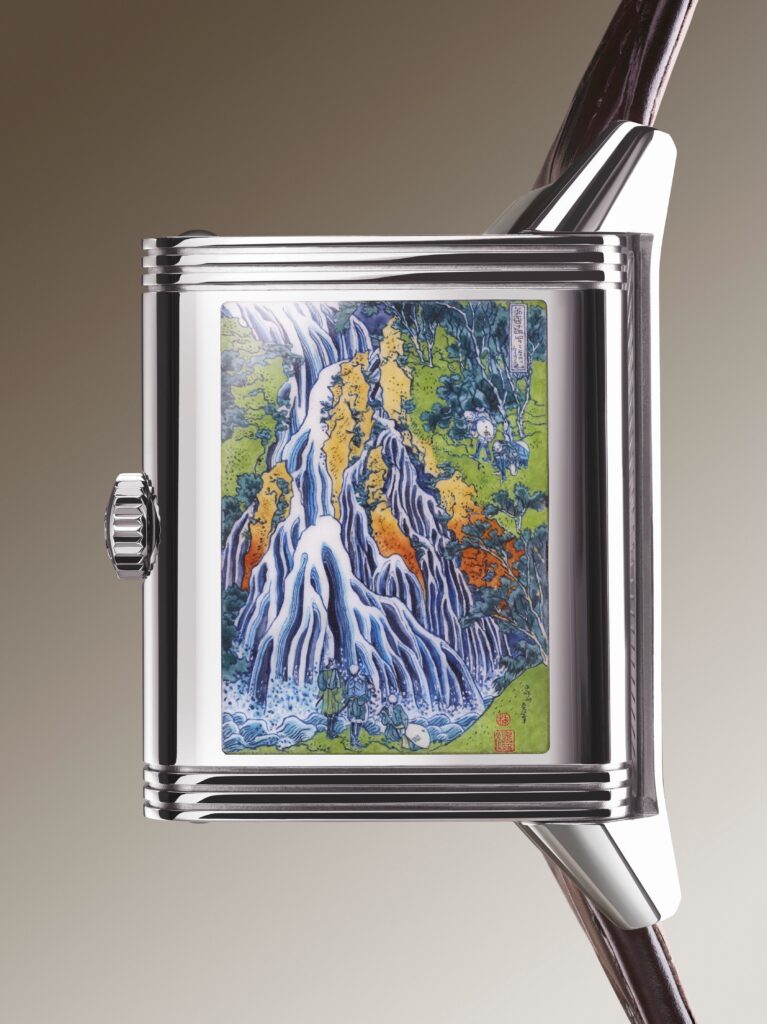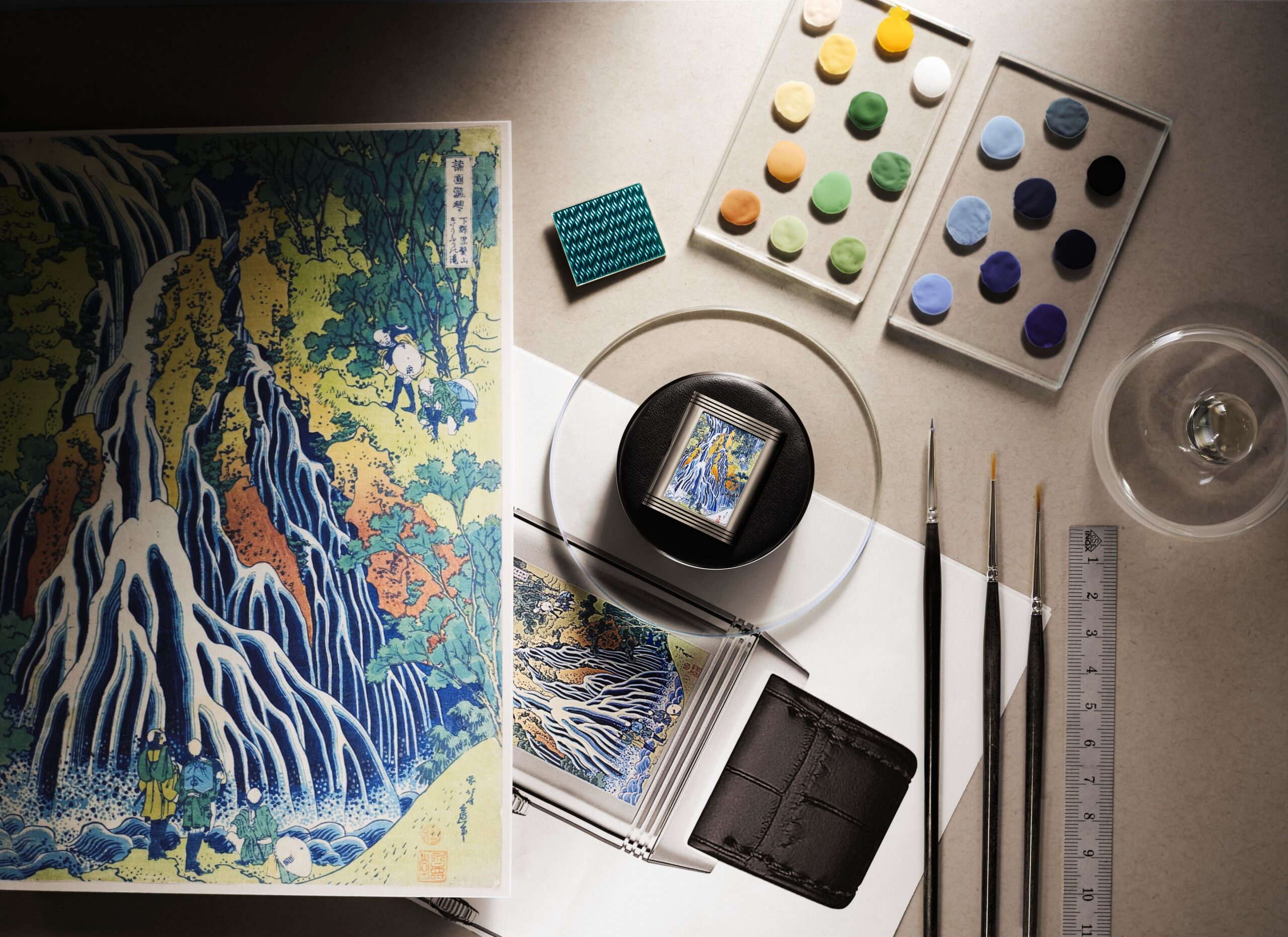
腕表背面融汇欧洲工艺与日本艺术,以珐琅微绘忠实再现葛饰北斋于 19 世纪 30 年代早期创作的木刻版 画《诸国瀑布览胜 下野黑发山之瀑》。这位艺术家于1831年至1833年之间游历了日本最大岛——本 州岛的不同地区,随后绘制了《诸国瀑布览胜》系列共八幅木版画,而《诸国瀑布览胜 下野黑发山之 瀑》便是其中之一。
新款时计凝聚积家珍稀工艺(Métiers Rares)工作坊中能工巧匠的出色才华与精湛技艺,彰显大工坊 的灵动创意及对艺术与文化世界的展望。
精密的工艺流程从表背润饰开始,由于工艺特殊,整个制作过程面临重重挑战。其中第一项挑战,是将 37 x 24.5厘米的原版画作呈现在仅有原作十分之一大小的表背上,同时确保以完美比例展现每一处细 节,包括位于瀑布底部的微细人群。
为了表现水流从高达 100 米的山坡上倾泻直下的磅礴气势与美感,葛饰北斋的《下野黑发山之瀑》在透 视与用色方面比以往作品更加大胆。珐琅工艺师不仅需要精准临摹原作,还要运用珐琅工艺模仿木版画 技巧,令微绘呈现出与珐琅截然不同的特殊质感。而另一项特殊挑战,则在于彩色版画需要运用多块单 色木版轮流上色,因此运用珐琅工艺复制出原作中微妙的“色彩渐变技法”(bokashi)以展现细腻的 色彩,更是难上加难。为此,积家珐琅大师必须自行研发工艺。
Reverso Tribute 翻转系列腕表的表盘风格简约,搭配镶贴刻面时标和太子妃式指针,充分凸显其精致 美感。表盘饰以难得一见的波浪形玑镂饰纹,犹如水波起伏,以艺术手法呼应表壳背面的微绘画作。工 艺大师借助拥有百年历史的车床,以特殊凸轮手工加工这一图案,并运用多层半透明的大明火珐琅增强 水波跌宕的视觉效果,而珐琅柔美淡雅的绿色调,恰好与表背画作的细节相呼应。经多次烧制令珐琅层层固定后,最终的挑战在于如何准确无误地镶贴时标(需要在珐琅清澈透明的表面 钻出小孔)并转印火车铁轨式分钟刻度。
由于珐琅在烧制过程中可能出现无法预料的色彩变化,因此在制作 Reverso Tribute Enamel Hokusai 翻转系列腕表的正面和背面时,需要耗费数小时进行研究和尝试,才能确保表盘色泽与背面微绘完美匹 配,同时令微绘忠实再现葛饰北斋原版画作的色彩。除了研发所需时间外,仅玑镂饰纹工序就需要 5 小 时,而之后还需要 8 小时层层涂覆半透明绿色珐琅。仅绘制表壳背面的微绘画作,就需耗费超过 70 小 时。
Uniting European craftsmanship with Japanese art, the reverse side of the case celebrates Eastern art with an enamel miniature painting that faithfully reproduces a woodblock print of Kirifuri Waterfall made by Katsushika Hokusai in the early 1830s. Kirifuri Waterfall is taken from A Tour of the Waterfalls of the Provinces, a series of eight woodblock prints depicting waterfalls that the artist visited between 1831 and 1833 in different regions of Japan’s main island, Honshu.
Embodying La Grande Maison’s creativity and its vision of the world of art and culture, the new timepiece is testament to the talent and skill of the artisans working in the Métiers Rares® (Rare Handcrafts) atelier within the Manufacture Jaeger-LeCoultre.
In a carefully orchestrated process beginning with the case back, the decoration of this timepiece presented many challenges that were particular to this work of art. First among those challenges was to reproduce a work measuring 37 x 24.5 cm onto a surface little more than one-tenth the size of the original – capturing every detail in perfect scale, including the group of tiny human figures at the base of the waterfall.
To express the power and beauty of the water as it cascades 100 metres down the mountainside Hokusai used a greater sense of perspective and bolder colours for Kirifuri Waterfall than in his previous work. The enameller had not only to mimic this perfectly but also to create the illusion of the woodblock printing technique, which produces a specific effect entirely different from enamelling. A particular challenge is that multi-coloured prints require the use of multiple woodblocks, with each different colour applied in turn – and there was the added challenge of reproducing the bokashi effect of subtly nuanced and graduated colours seen in the original. To achieve these illusions, Jaeger-LeCoultre’s master enameller had to develop her own technique.
The simplicity of the Reverso Tribute dial – with its faceted appliqué hour-markers and Dauphine hands – places full value on the beauty of its decoration. An artistic response to the miniature painting on the case back, this dial is decorated with an unusual, wavy guilloché pattern chosen to echo the effect of moving water. Executed by hand, using a century-old lathe for which a special cam was tooled to achieve this particular pattern, the visual effect of the waves is amplified by layers of translucent grand feu enamel in a soft shade of green that exactly matches a detail of the painting on the reverse side.
Following multiple firings to build up the enamel layers, the final challenge is the faultless application of the indexes (which requires tiny holes to be drilled through the pristine surface of the enamel) and the transfer of the chemin de fer minutes register.
As with all enamelling, the firing process can change colours in unpredictable ways, so for both the back and the front of the Reverso Tribute Enamel Hokusai, many hours of research and experiment were required in order that the dial colour would perfectly match the painting on the reverse, and that the painting would give a faithful rendering of Hokusai’s original colours. In addition to these hours of research, almost five working hours must be dedicated to the guillochage alone, followed by eight working hours for the layers of translucent green enamel. More than 70 working hours are required only to paint the miniature masterpiece on the case back.
All photos provided by Jaeger LeCoultre.

